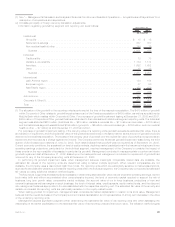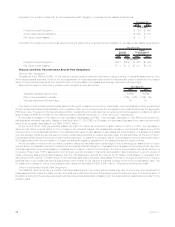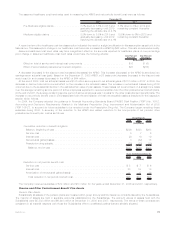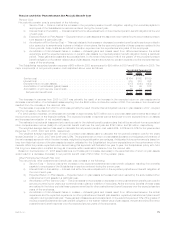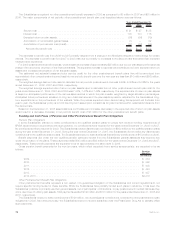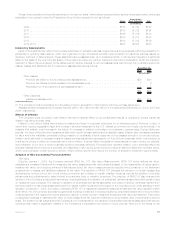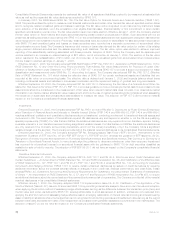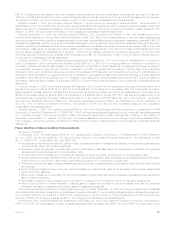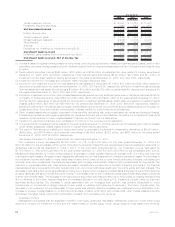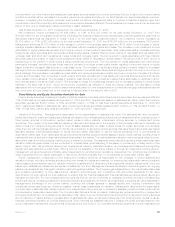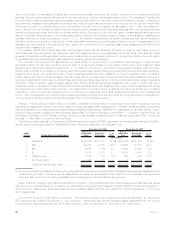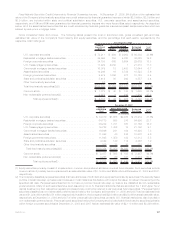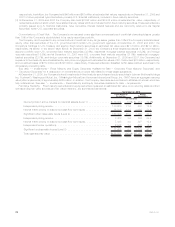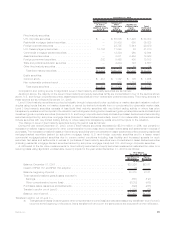MetLife 2008 Annual Report Download - page 82
Download and view the complete annual report
Please find page 82 of the 2008 MetLife annual report below. You can navigate through the pages in the report by either clicking on the pages listed below, or by using the keyword search tool below to find specific information within the annual report.Effective January 1, 2006, the Company adopted prospectively SFAS No. 155, Accounting for Certain Hybrid Instruments (“SFAS 155”).
SFAS 155 amends SFAS 133 and SFAS No. 140, Accounting for Transfers and Servicing of Financial Assets and Extinguishments of
Liabilities (“SFAS 140”). SFAS 155 allows financial instruments that have embedded derivatives to be accounted for as a whole, eliminating
the need to bifurcate the derivative from its host, if the holder elects to account for the whole instrument on a fair value basis. In addition,
among other changes, SFAS 155:
(i) clarifies which interest-only strips and principal-only strips are not subject to the requirements of SFAS 133;
(ii) establishes a requirement to evaluate interests in securitized financial assets to identify interests that are freestanding
derivatives or that are hybrid financial instruments that contain an embedded derivative requiring bifurcation;
(iii) clarifies that concentrations of credit risk in the form of subordination are not embedded derivatives; and
(iv) amends SFAS 140 to eliminate the prohibition on a QSPE from holding a derivative financial instrument that pertains to a
beneficial interest other than another derivative financial interest.
The adoption of SFAS 155 did not have a material impact on the Company’s consolidated financial statements.
Effective October 1, 2006, the Company adopted SFAS 133 Implementation Issue No. B40, Embedded Derivatives: Application of
Paragraph 13(b) to Securitized Interests in Prepayable Financial Assets (“Issue B40”). Issue B40 clarifies that a securitized interest in
prepayable financial assets is not subject to the conditions in paragraph 13(b) of SFAS 133, if it meets both of the following criteria: (i) the
right to accelerate the settlement if the securitized interest cannot be controlled by the investor; and (ii) the securitized interest itself does
not contain an embedded derivative (including an interest rate-related derivative) for which bifurcation would be required other than an
embedded derivative that results solely from the embedded call options in the underlying financial assets. The adoption of Issue B40 did
not have a material impact on the Company’s consolidated financial statements.
Effective January 1, 2006, the Company adopted prospectively SFAS 133 Implementation Issue No. B38, Embedded Derivatives:
Evaluation of Net Settlement with Respect to the Settlement of a Debt Instrument through Exercise of an Embedded Put Option or Call
Option (“Issue B38”) and SFAS 133 Implementation Issue No. B39, Embedded Derivatives: Application of Paragraph 13(b) to Call Options
That Are Exercisable Only by the Debtor (“Issue B39”). Issue B38 clarifies that the potential settlement of a debtor’s obligation to a creditor
occurring upon exercise of a put or call option meets the net settlement criteria of SFAS 133. Issue B39 clarifies that an embedded call
option, in which the underlying is an interest rate or interest rate index, that can accelerate the settlement of a debt host financial instrument
should not be bifurcated and fair valued if the right to accelerate the settlement can be exercised only by the debtor (issuer/borrower) and
the investor will recover substantially all of its initial net investment. The adoption of Issues B38 and B39 did not have a material impact on
the Company’s consolidated financial statements.
Income Taxes
Effective January 1, 2007, the Company adopted FIN 48. FIN 48 clarifies the accounting for uncertainty in income tax recognized in a
company’s financial statements. FIN 48 requires companies to determine whether it is “more likely than not” that a tax position will be
sustained upon examination by the appropriate taxing authorities before any part of the benefit can be recorded in the financial statements.
It also provides guidance on the recognition, measurement, and classification of income tax uncertainties, along with any related interest
and penalties. Previously recorded income tax benefits that no longer meet this standard are required to be charged to earnings in the
period that such determination is made.
As a result of the implementation of FIN 48, the Company recognized a $35 million increase in the liability for unrecognized tax benefits
and a $9 million decrease in the interest liability for unrecognized tax benefits, as well as a $17 million increase in the liability for
unrecognized tax benefits and a $5 million increase in the interest liability for unrecognized tax benefits which are included in liabilities of
subsidiaries held-for-sale. The corresponding reduction to the January 1, 2007 balance of retained earnings was $37 million, net of
$11 million of minority interest included in liabilities of subsidiaries held-for-sale. See also Note 15 of the Notes to the Consolidated
Financial Statements.
Insurance Contracts
Effective January 1, 2007, the Company adopted SOP 05-1 which provides guidance on accounting by insurance enterprises for DAC
on internal replacements of insurance and investment contracts other than those specifically described in SFAS No. 97, Accounting and
Reporting by Insurance Enterprises for Certain Long-Duration Contracts and for Realized Gains and Losses from the Sale of Investments.
SOP 05-1 defines an internal replacement and is effective for internal replacements occurring in fiscal years beginning after December 15,
2006. In addition, in February 2007, the American Institute of Certified Public Accountants (“AICPA”) issued related Technical Practice Aids
(“TPAs”) to provide further clarification of SOP 05-1. The TPAs became effective concurrently with the adoption of SOP 05-1.
As a result of the adoption of SOP 05-1 and the related TPAs, if an internal replacement modification substantially changes a contract,
then the DAC is written off immediately through income and any new deferrable costs associated with the new replacement are deferred. If
a contract modification does not substantially change the contract, the DAC amortization on the original contract will continue and any
acquisition costs associated with the related modification are immediately expensed.
The adoption of SOP 05-1 and the related TPAs resulted in a reduction to DAC and VOBA on January 1, 2007 and an acceleration of the
amortization period relating primarily to the Company’s group life and health insurance contracts that contain certain rate reset provisions.
PriortotheadoptionofSOP05-1,DAConsuchcontractswasamortized over the expected renewable life of the contract. Upon adoption
of SOP 05-1, DAC on such contracts is to be amortized over the rate reset period. The impact as of January 1, 2007 was a cumulative
effect adjustment of $292 million, net of income tax of $161 million, which was recorded as a reduction to retained earnings.
Defined Benefit and Other Postretirement Plans
Effective December 31, 2006, the Company adopted SFAS 158. The pronouncement revises financial reporting standards for defined
benefit pension and other postretirement plans by requiring the:
(i) recognition in the statement of financial position of the funded status of defined benefit plans measured as the difference
between the estimated fair value of plan assets and the benefit obligation, which is the projected benefit obligation for
pension plans and the accumulated postretirement benefit obligation for other postretirement plans;
79MetLife, Inc.


